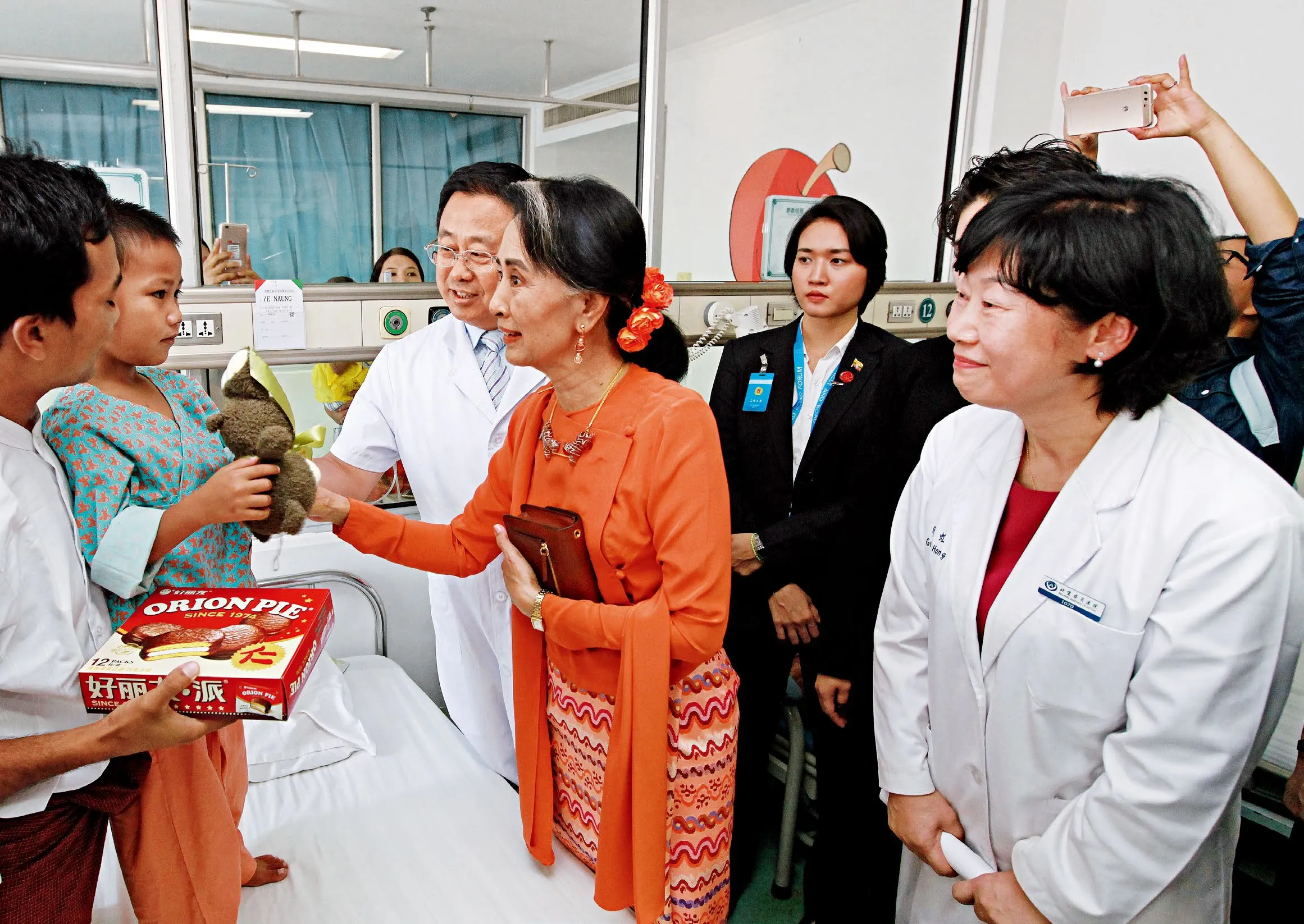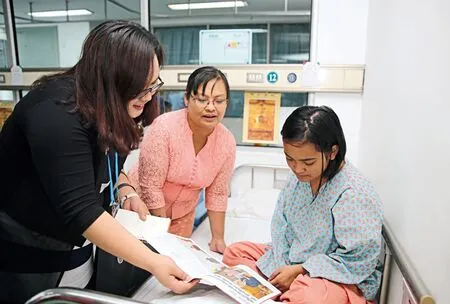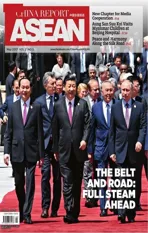Aung San Suu Kyi Visits Myanmar Children at Beijing Hospital
2017-07-18By
By
Aung San Suu Kyi Visits Myanmar Children at Beijing Hospital
ByWang Fengjuan
At 4:00 p.m. on the afternoon of May 16, the day after the conclusion of the Belt and Road Forum for International Cooperation in Beijing, Myanmar’s State Counsellor Aung San Suu Kyi, dressed in an orange longyi, traveled to Beijing Anzhen Hospital in the bright sunshine of early summer. She was there to visit the fi rst group of Myanmar Children receiving treatment for congenital heart disease (CHD) at the hospital.
Happy Smile
Aung San Suu Kyi was all smiles greeting the children as they lay in their hospital beds. She was briefed on the children’s conditions by the attending surgeons. She leaned forward to speak to Win Lae Phyo, one of the children receiving treatment.
“Hey there. How old are you?”“Hello, mam. I’m Win Lae Phyo. I’m fi ve.”
“How are you feeling now?”
“Since the doctors fi nished my operation, I have felt much better. I don’t feel so tired now,”Win said.
“Don’t worry, Chinese doctors are excellent,” Aung San Suu Kyi told him. “The surgeons conducted the surgery on the side of your body, which is a very advanced surgery. And they succeeded. You’ll be well soon!”Aung San Suu Kyi proceeded to visit all the other patients and presented them with cookies and teddy bears.
Win Lae Phyo’s dark eyes blinked. She was diagnosed as a CHD patient at birth. On this trip to Beijing, her illness was treated, while she also got to know some of the attending doctors and nurses in the hospital. She even learned a few Chinese words from the nurses. In her small voice, Win told our reporter: “I love Beijing. People here have been so kind to me. I love them so much.”
Win’s grandmother was here with her. She was in a pleasant mood. “Win was very lucky to get this free treatment in China,”said the granny, kindly smiling at Win. “Chinese doctors cured the child of her disease. I don’t know how I can thank them enough.”
Win Lae Phyo and 11 other children make up the fi rst group of Myanmar CHD patients to come to Beijing for treatment. The oldest is 16 years old, while the youngest is aged just 20 months.
Transboundary Love
At the end of March 2017, the charity project of medical assistance for CHD children in Myanmar kicked of f. The project was organized by the China Charity Federation (CCF) and conducted by CCF’s press charity promotion association. With CHD screening by Beijing Anzhen Hospital, 54 Myanmar patients were shortlisted for treatment in China in groups.

Aung San Suu Kyi brought gifts of cookies and teddy bears for the Myanmar children at Anzhen Hospital in Beijing.
“Last year, I was in Yangon as a volunteer working on CHD screening. A decision was made for the CCF to provide medical assistance in Beijing for patients who need it. Anzhen Hospital provided both the expert consultations and the surgeries,” said Su Junwu, deputy chief of Anzhen Hospital’s Center of Pediatric Heart Disease. Su said that all of the patients were very ill. Surgery will not only improve their lives, but also provide them with a strong heart for the future.
Seeing Su on his rounds, a young patient waved to him cheerfully. When asked about the follow-up treatment, Su showed our reporter his mobile phone. “We exchange views on the treatment plan with the Myanmar doctors on WeChat every day. When the children go back to Myanmar, we’ll be updated on their condition, and we’ll give them more advice, ”Su said.
After consultations and surgeries performed by Chinese doctors, seven of the patients were discharged from the hospital on May 17, one is in follow-up treatment and the other four are preparing for surgery.
Myanmar is a country with a relatively high incidence of CHD. Currently, there are only three Myanmar hospitals capable of treating CHD. The country’s overstretched hospitals have to put many patients on waiting lists. What’s more, the annual income of the average Myanmar citizen is roughly US$1,300, which makes it very difficult for ordinary families to af f ord a surgery that typically costs more than US$20,000. Due to fi nancial difficulties, many CHD patients who are in urgent need of surgery have to survive on medication.
“This is my fi rst trip to China,” said the oldest of all the children. “It has been like adream. When I was very young, I was diagnosed with the disease. My family could not af f ord the surgery. I thank you, China. I thank you for having me here for treatment. When I go back, I will be able to go to school as a normal student, and not have to miss school all the time.”
This group of Myanmar patients have suf f ered from the disease for most of their lives. Because they didn’t receive timely treatment, their bodies remain underdeveloped. Most of them were diagnosed as patients with complicated conditions after screening by medical experts from other countries. Anzhen Hospital believes that with proper treatment, most of the patients have recovered well. The hospital is ready to provide the Myanmar side with technical support in rehabilitation. Anzhen is a comprehensive hospital specializing in the treatment of heart, lung and vascular diseases. The hospital’s Center of Pediatric Heart Disease performs more than 4,000 CHD surgeries every year. The hospital has expressed its willingness for further participation in the charity project to contribute to the traditional pauk-phaw (brotherly) friendship between China and Myanmar.
Healthcare and Rehabilitation Projects
In his speech at the opening ceremony of the Belt and Road Forum for International Cooperation, President Xi Jinping stated that China will provide assistance to developing countries and international organizations participating in the Belt and Road Initiative, including 100 healthcare and rehabilitation projects.

Top: Aung San Suu Kyi inquires about the details of a child’s treatment.

Bottom left: A young patient from Myanmar examining a special edition ofChina Report ASEAN.

Bottom right: Win Lae Phyo’s grandmother was in a pleasant mood.
“To save a child is to save an entire family,” said Li Bengong, President of the China Charity Federation. “This charity project has solved a serious problem for these Myanmar children and their families.”The project, organized by the CCF, also benef i ted from the support of Chinese and Myanmar diplomatic missions and relevant government departments. Li further noted that his charity will continue to play its part as a non-governmental organization working to enhance the traditional paukphaw friendship that exists between the people of China and Myanmar. They are ready to provide timely assistance for the people of Myanmar and contribute to the people-topeople bonds between the two countries.
Surgery is only the beginning of a long journey. Next, the CCF will team up with Chinese hospitals with advanced technology to provide their Myanmar counterparts with technical assistance. Communication, exchanges and learning among the professionals will result in better service for Myanmar patients, which will in turn add to the pauk-phaw friendship.

Aung San Suu Kyi (center, front row), Chinese Ambassador to Myanmar Hong Liang (second left, back row), Myanmar Ambassador to China U Thit Linn Ohn (third left, back row) and others pose with Myanmar children and their families.
Our reporter noticed that the initial surgical incisions were conducted not on the patients’chests, but on the sides of their bodies. Su explained that it takes longer to recover from the traditional thoracotomy surgery, which requires a chest incision. The patients may face psychological harm later in life with a prominent chest scar. As long as it’s feasible, the doctors said they give priority to surgery on the patients’ side.“This method of operation is advanced worldwide,” Su said.
Chinese Ambassador to Myanmar Hong Liang thinks that this charity project organized by the CCF is not just a way to provide medical assistance for Myanmar pediatric heart disease patients, but also an opportunity for the exchange of skills in pediatric heart disease treatment between the two countries. He believes that the project will further promote friendly cooperation and bilateral relations between China and Myanmar.
Accompanying Aung San Suu Kyi during this visit were Chinese Ambassador to Myanmar Hong Liang, Myanmar Ambassador to China U Thit Linn Ohn, Deputy Director of the Beijing Municipal Health and Family Planning Commission Lei Haichao, Deputy Inspector of the Beijing Municipal Hospital Authority Xu Changshun, Myanmar Minister of Transport and Communications U Thant Sin Maung, Myanmar Minister of Construction U Win Khaing, Myanmar Minister of State for Foreign Af f airs U Kyaw Tin, Myanmar Deputy Minister of Commerce U Aung Htoo, Beijing Anzhen Hospital President Wei Yongxiang, the hospital’s Party Secretary Jin Chunming and others.
In an ef f ort to give the Myanmar children a better understanding of China, the host of the project organized a city tour of Beijing the day after they arrived, which took them to Tian’anmen Square, the Tian’anmen Rostrum, the Bird’s Nest stadium and the Water Cube in the Olympic Park. As their bus was driving along the bustling streets, the children were excited to get a good view of the city. This marked their fi rst trip to China, a trip full of curiosity and expectations. Whenever they saw something they found to be unique or special, they stopped with their families to pose for a picture.
12 children
treatment for congenital heart disease that their families would be unable to afford back home
